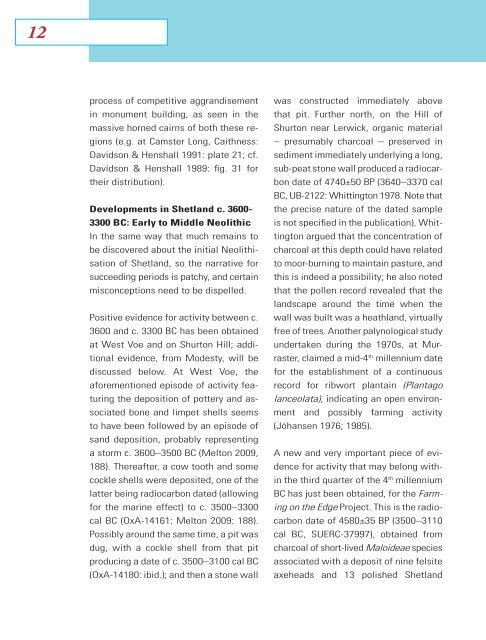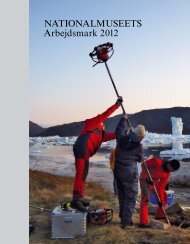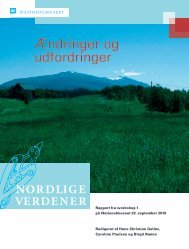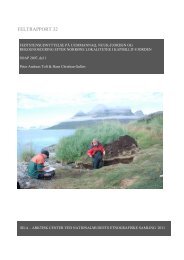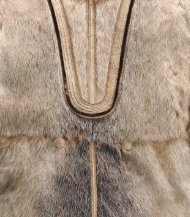The Border of Farming and the Cultural Markers - Nordlige Verdener
The Border of Farming and the Cultural Markers - Nordlige Verdener
The Border of Farming and the Cultural Markers - Nordlige Verdener
Create successful ePaper yourself
Turn your PDF publications into a flip-book with our unique Google optimized e-Paper software.
12<br />
process <strong>of</strong> competitive aggr<strong>and</strong>isement<br />
in monument building, as seen in <strong>the</strong><br />
massive horned cairns <strong>of</strong> both <strong>the</strong>se regions<br />
(e.g. at Camster Long, Caithness:<br />
Davidson & Henshall 1991: plate 21; cf.<br />
Davidson & Henshall 1989: fig. 31 for<br />
<strong>the</strong>ir distribution).<br />
Developments in Shetl<strong>and</strong> c. 3600-<br />
3300 BC: Early to Middle Neolithic<br />
In <strong>the</strong> same way that much remains to<br />
be discovered about <strong>the</strong> initial Neolithisation<br />
<strong>of</strong> Shetl<strong>and</strong>, so <strong>the</strong> narrative for<br />
succeeding periods is patchy, <strong>and</strong> certain<br />
misconceptions need to be dispelled.<br />
Positive evidence for activity between c.<br />
3600 <strong>and</strong> c. 3300 BC has been obtained<br />
at West Voe <strong>and</strong> on Shurton Hill; additional<br />
evidence, from Modesty, will be<br />
discussed below. At West Voe, <strong>the</strong><br />
aforementioned episode <strong>of</strong> activity featuring<br />
<strong>the</strong> deposition <strong>of</strong> pottery <strong>and</strong> associated<br />
bone <strong>and</strong> limpet shells seems<br />
to have been followed by an episode <strong>of</strong><br />
s<strong>and</strong> deposition, probably representing<br />
a storm c. 3600–3500 BC (Melton 2009,<br />
188). <strong>The</strong>reafter, a cow tooth <strong>and</strong> some<br />
cockle shells were deposited, one <strong>of</strong> <strong>the</strong><br />
latter being radiocarbon dated (allowing<br />
for <strong>the</strong> marine effect) to c. 3500–3300<br />
cal BC (OxA-14161: Melton 2009: 188).<br />
Possibly around <strong>the</strong> same time, a pit was<br />
dug, with a cockle shell from that pit<br />
producing a date <strong>of</strong> c. 3500–3100 cal BC<br />
(OxA-14180: ibid.); <strong>and</strong> <strong>the</strong>n a stone wall<br />
was constructed immediately above<br />
that pit. Fur<strong>the</strong>r north, on <strong>the</strong> Hill <strong>of</strong><br />
Shurton near Lerwick, organic material<br />
– presumably charcoal – preserved in<br />
sediment immediately underlying a long,<br />
sub-peat stone wall produced a radiocarbon<br />
date <strong>of</strong> 4740±50 BP (3640–3370 cal<br />
BC, UB-2122: Whittington 1978. Note that<br />
<strong>the</strong> precise nature <strong>of</strong> <strong>the</strong> dated sample<br />
is not specified in <strong>the</strong> publication). Whittington<br />
argued that <strong>the</strong> concentration <strong>of</strong><br />
charcoal at this depth could have related<br />
to moor-burning to maintain pasture, <strong>and</strong><br />
this is indeed a possibility; he also noted<br />
that <strong>the</strong> pollen record revealed that <strong>the</strong><br />
l<strong>and</strong>scape around <strong>the</strong> time when <strong>the</strong><br />
wall was built was a heathl<strong>and</strong>, virtually<br />
free <strong>of</strong> trees. Ano<strong>the</strong>r palynological study<br />
undertaken during <strong>the</strong> 1970s, at Murraster,<br />
claimed a mid-4 th millennium date<br />
for <strong>the</strong> establishment <strong>of</strong> a continuous<br />
record for ribwort plantain (Plantago<br />
lanceolata), indicating an open environment<br />
<strong>and</strong> possibly farming activity<br />
(Jóhansen 1976; 1985).<br />
A new <strong>and</strong> very important piece <strong>of</strong> evidence<br />
for activity that may belong within<br />
<strong>the</strong> third quarter <strong>of</strong> <strong>the</strong> 4 th millennium<br />
BC has just been obtained, for <strong>the</strong> <strong>Farming</strong><br />
on <strong>the</strong> Edge Project. This is <strong>the</strong> radiocarbon<br />
date <strong>of</strong> 4580±35 BP (3500–3110<br />
cal BC, SUERC-37997), obtained from<br />
charcoal <strong>of</strong> short-lived Maloideae species<br />
associated with a deposit <strong>of</strong> nine felsite<br />
axeheads <strong>and</strong> 13 polished Shetl<strong>and</strong>


